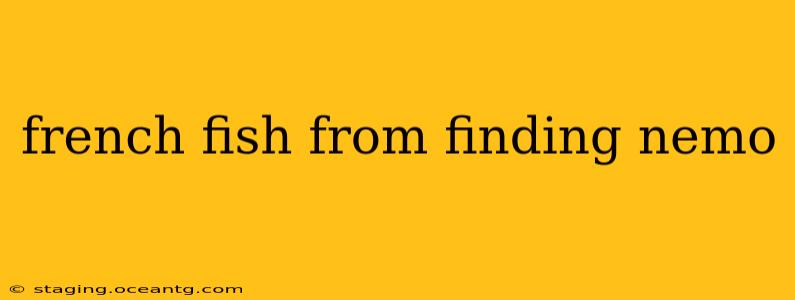Finding Nemo captivated audiences worldwide with its vibrant underwater world and memorable characters. Among them, Gill, the grumpy but ultimately kind tank fish, sparks curiosity with his unique appearance. Many viewers wonder: what kind of fish is Gill? Let's dive into the fascinating world of Finding Nemo's characters and uncover the truth about Gill's species.
While Pixar never explicitly names Gill's species in the film, his physical characteristics strongly suggest he's a Moorish Idol (Zanclus cornutus).
What kind of fish is Gill from Finding Nemo?
Gill's distinctive features perfectly match those of a Moorish Idol. He possesses a tall, laterally compressed body, a prominent, elongated dorsal fin, and a striking black and yellow coloration. His most recognizable feature, the long, flowing filaments extending from his dorsal and caudal fins, are a hallmark of the Moorish Idol. These delicate streamers give him a regal, almost whimsical appearance.
Is Gill a Moorish Idol?
Although not explicitly stated, the visual similarities between Gill and the Moorish Idol are overwhelming. This visual identification is widely accepted by fans and many animation enthusiasts. While other fish share some similarities, the combination of traits—tall body, distinctive fin shape, and striking black and yellow coloration—strongly points to the Moorish Idol as the most likely inspiration for Gill's character design.
What are the characteristics of a Moorish Idol?
Moorish Idols are known for their elegance and beauty. They are:
- Ornate Appearance: Their striking black and yellow coloration, combined with their graceful fins, makes them instantly recognizable.
- Delicate Fins: Their long, flowing dorsal and caudal fins are particularly striking and contribute to their delicate appearance.
- Small Size: These fish are relatively small, reaching a maximum length of about 20 centimeters (8 inches).
- Grazing Habits: They primarily feed on algae and small invertebrates.
- Challenging Captivity: Moorish Idols are notoriously difficult to keep in captivity, often suffering stress and failing to thrive in aquariums.
Why is Gill's species important?
Understanding Gill's species helps us appreciate the careful detail Pixar put into creating this underwater world. The accurate portrayal of a Moorish Idol, even if not explicitly mentioned, enhances the film's realism and enriches the audience's viewing experience. It also allows us to connect Gill's personality—determined yet vulnerable—to the challenges faced by Moorish Idols in their natural environment.
Are Moorish Idols difficult to keep in an aquarium?
Yes, Moorish Idols are notoriously difficult to maintain in captivity. They are highly susceptible to stress and have specific dietary needs. They require live food and meticulously maintained water conditions. Their delicate nature makes them prone to illness, which further complicates their aquarium care. This fact adds another layer to the story, potentially explaining Gill's cynical attitude and desire to return to the ocean. He knows, intuitively, the fragility of his species and the hardship of survival outside its natural habitat.
What other fish are in Finding Nemo?
Finding Nemo features a diverse array of marine life, including:
- Clownfish (Nemo's species): The Ocellaris Clownfish, also known as the Percula Clownfish.
- Royal Gramma: A small, brightly colored fish often seen in coral reefs.
- Parrotfish: Known for their beak-like mouths used to graze on coral.
- Surgeonfish: A group of fish characterized by sharp spines near their tails.
- Various invertebrates: Including sea anemones, crabs, and jellyfish.
The vibrant underwater world of Finding Nemo is rich in detail, and identifying the species featured in the film adds another layer of appreciation for Pixar's meticulous artistry.
This detailed look at Gill's likely species and other Finding Nemo fish demonstrates the film's commitment to creating a believable and captivating underwater world. The meticulous detail goes beyond simply creating cute characters and extends to portraying the intricacies and challenges of marine life.
